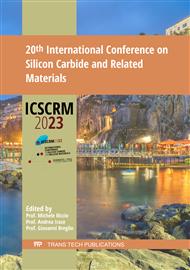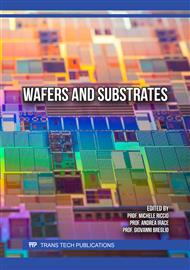[1]
S. Rouchier et al., Materials Sience Forum, vol. 1062, p.131–135, 2021.
Google Scholar
[2]
K. Imakoa et al., UN patent 9 761 749 B2, 2017.
Google Scholar
[3]
A. Yi et al., Optical Materials, vol. 107, p.109990, 2020.
Google Scholar
[4]
F. Mu and T. Suga, presented at ICEP 2019, Japan, 2019, p.198–199.
Google Scholar
[5]
F. Mu et al., Journal of Solid State Sciuence and Technology, vol. 5, no. 9, p.451–456, 2016.
Google Scholar
[6]
W. Zhang et al., Micromachines, vol. 12, no. 12, p.1575, 2021.
Google Scholar
[7]
W. Schwarzenbach et al., presented at ICSCRM 2022, Davos, Switzerland, 2022.
Google Scholar
[8]
E. Cela et al., Defect and Diffusion Forum, vol. 425, p.57–61, 2023.
Google Scholar
[9]
B. Kallinger et al., Solid State Phenomena, vol. 342, p.91–98, 2023.
Google Scholar
[10]
D. Zhu et al., physica status solidi (a), vol. 220, no. 3, p.2370005, 2023.
Google Scholar
[11]
H. Ou et al., Materials, vol. 16, no. 3, Art. no. 3, 2023.
Google Scholar
[12]
M. Bruel et al., in 1995 IEEE International SOI Conference Proceedings, 1995, p.178–179.
Google Scholar
[13]
L. Di Cioccio et al., Materials Science and Engineering: B, vol. 46, no. 1, p.349–356, 1997.
Google Scholar
[14]
X. Zhang et al., Nuc. Inst. Methods Phys. Res. B, vol. 436, p.107–111, (2018)
Google Scholar
[15]
Y. Le Tiec, Ph.D. thesis, Science et Génie des Matériaux, INP Grenoble & CEA-Leti, 1998.
Google Scholar
[16]
L. Di Cioccio et al., in Wafer Bonding: Applications and Technology (M. Alexe and U. Gösele), Eds., in Springer Series in Materials Science. Springer, 2004, p.263–314.
DOI: 10.1007/978-3-662-10827-7
Google Scholar
[17]
E. Hugonnard-Bruyère et al., Materials Siences and Engineering: B, vol. 61–62, p.382–388, 1999.
Google Scholar
[18]
F. Letertre et al., Materials Sciences Forum, vol. 433–436, p.813–818, 2003.
Google Scholar
[19]
G. Gelineau et al., Materials Science Forum, vol. 1089, p.71–79, 2023.
Google Scholar
[20]
C. Ventosa et al., Journal of Applied Physics, vol. 104, no. 12, p.123524, 2008.
Google Scholar
[21]
G. Rutsch et al., Journal of Applied Physics, vol. 84, no. 4, p.2062–2064, 1998.
Google Scholar
[22]
A. AlQurashi and C. R. Selvakumar, Superlattice Microsctrucures., vol. 118, p.308–318.
Google Scholar
[23]
F. Schmid et al., Phys. rev. B, vol. 74, p.245212, 2006.
Google Scholar
[24]
B. S. Li et al., Nuc. Inst. Methods Phys. Res. B, vol. 316, no. 239, p.244, 2013.
Google Scholar
[25]
N. Daghbouj et al., Acta Materialia, vol. 188, p.609–622, 2020.
Google Scholar
[26]
Kimoto, T. and Cooper, J.A., Fundamentals of Silicon Carbide Technology: Growth Characterization Devices and Applications, John Wiley&Sons. 2014.
DOI: 10.1002/9781118313534
Google Scholar
[27]
X. Zhou et al., Mat. Sci. Forum, vol. 963 MSF, p.516–5159, 2019.
Google Scholar
[28]
M. A. Capano et al., J. Appl. Phys., vol. 87, no. 12, p.8773, 2000.
Google Scholar
[29]
J. Pernot, Journal of Applied Physics, vol. 90, 2001.
Google Scholar
[30]
W. Götz et al., Journal of Applied Physics, vol. 73, no. 7, p.3332–3338, 1993.
Google Scholar
[31]
G. Pensl and W. J. Choyke, Physica B: Condensed Matter, vol. 185, no. 1, p.264–283, 1993.
Google Scholar
[32]
H. Li et al., Front. Phys., vol. 9, 2022.
Google Scholar
[33]
H. Sako et al., Journal of Applied Physics, vol. 119, no. 13, p.135702, 2016.
Google Scholar
[34]
W. Geng et al., J. Semicond., vol. 43, no. 10, p.102801, 2022.
Google Scholar
[35]
F. Gendron et al., Appl. Phys. Lett., vol. 67, no. 9, p.1253–1255, 1995.
Google Scholar
[36]
W. J. Choyke, H. Matsunami, and G. Pensl, Silicon Carbode: Recent Major Advances, Springer-Verlag., vol. 1. Berlin, Germany: Heidelberg GmbH, 2004.
Google Scholar
[37]
M. E. Bathen et al., ournal of. Applied Physics, vol. 127, p.085701, 2020.
Google Scholar



